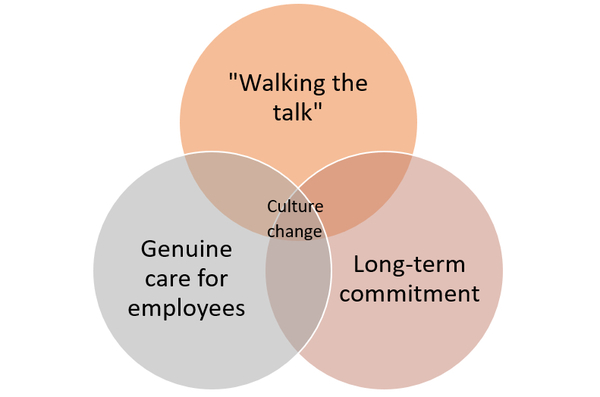THE WORLD’S #1 EXECUTIVE COACHING AND BUSINESS COACHING BLOG SINCE 2017.
Why Leaders Must Understand Corporate Culture in the Business World
Published On: July 25, 2019 | Last updated on: January 10, 2025 | Author: John Mattone | Category: Blog, Cultural Transformation
Organizational culture and leadership are closely intertwined.

Without strong leadership, you can’t have a strong corporate culture.
Ensuring a great corporate culture requires addressing leadership problems, and in many ways, ensuring great leadership requires addressing corporate culture problems. Sometimes, making lasting positive changes requires the help of cultural change consultants, but not always. Organizations that monitor culture and address problems early can keep culture on the right track, but it requires commitment and work.
There’s no question that strong corporate culture is considered essential for business success. While the positives of good corporate culture may show up in subtle ways, anyone who has worked for a company with a bad or negative culture can attest that bad culture is blatant. Employee turnover is higher, and people plain don’t like going to work every day. Eventually, bad culture eats into revenues.
Today, more than at any time in the past, business runs on data, and that can make corporate culture feel subjective and unimportant. But make no mistake: companies with great culture are far more likely to succeed, and companies with bad culture are far more likely to struggle. Here is what executives and other leaders must know about corporate culture, how important it is, and how to turn around ailing corporate culture.
What Is Corporate Culture?
Corporate culture is made up of the values and behaviors that permeate the environment of the organization. Culture is “what it’s like” to be a part of the organization. So important is corporate culture that most people claim to value a company’s culture above salary with regard to their job satisfaction!
Job seekers tend not to apply at and not to accept positions at companies whose values don’t align with their own. In other words, job seekers are attracted to companies that have a clearly defined mission that they believe they can support wholeheartedly.
The beliefs, values, and behaviors that are demonstrated day after day are the key elements in corporate culture, and employees aren’t fooled by companies that claim to have certain values without actually demonstrating them.
What are the behaviors that demonstrate company culture? They vary from industry to industry and based on broader societal norms, but typically you’ll see company culture reflected in things like:
- Business hours
- How the office is physically organized
- Hiring decisions
- Dress codes
- Treatment of clients
- Treatment of employees
Like it or not, your company culture is on display every day during ordinary operations, and it is evident to everyone in that environment.
Culture is made up of several elements, with vision / values, practices / people, and work environment being key.
Companies Known for Having Great Corporate Culture
Some companies known for having a great organizational culture are famous, while others are ones you may never have heard of. Big companies with reputations for great culture include Costco, T-Mobile, and Hubspot.
Costco was awarded “best company culture” by career monitoring website Comparably because of its high marks for compensation, leadership, professional development, work-life balance, and benefits.
On Fortune’s 100 Best Places to Work in 2019, T-Mobile came in at number 49. The company encourages employees to celebrate diversity of all kinds, promote passion, and emphasize doing the right thing for the right reasons.
HubSpot, according to Business Insider, attributes its great company culture to ensuring that team members’ voices are heard, ensuring its values are clear, and emphasizing the importance of people in every aspect of business.
Though not as big and famous as the above-mentioned companies, Seattle-based Highspot was recognized as a “Top 10 Best Place to Work” by Glassdoor in 2018. The company credits its belief in collaboration, breaking boundaries, and freeing people to do their best work for the accolades.
Boston-based conversational marketing platform company Drift has also won awards for their culture. Drift says its recruiting is geared toward inclusiveness and diversity, and it cultivates relationships with local STEM programs to build strong teams over the long term.
How Does Company Culture Develop?
Company culture develops whether or not leadership helps shape it. While it might seem like a good idea to let culture develop “organically,” it really isn’t. Theoretically, it’s possible for a great set of people who work well together to create a positive and thriving company culture. But it only takes one or two people to turn unmanaged culture into more of a “Lord of the Flies” situation.
Strong, positive company culture develops based on shared values and leadership. Throw a handful of seeds into a sunny patch of dirt and you might get a few scraggly pieces of produce, but it will probably be choked out by weeds, washed away by rain, or baked into oblivion by drought. Company culture must be planned, initiated, and cultivated the way you would a prized garden: with learning, planning, and sustained hard work.
When leadership prioritizes corporate culture and puts the necessary strategy, planning, and work into it, the results can be phenomenal. A thriving company culture is an incredibly valuable business asset, just like a company’s equipment and facilities are.
Warning Signs That Corporate Culture Is in Trouble
Bad corporate culture can’t be papered over or ignored.
Since it’s a living entity made up of humans, corporate culture is never going to be perfect. Every person will have good and bad days, and every company will have good and bad days. Culture that is genuinely in trouble, however, will show several clear warning signs. Here are some of the main red flags to look for that indicate culture isn’t as healthy as it needs to be:
- High levels of employee turnover. When high turnover comes to be the norm, it’s a major sign that something is seriously amiss with culture.
- Interdepartmental tension. Departments that always seem to be at odds with each other indicate that higher leadership has lost control of certain aspects of culture.
- Personal drama. When people regularly bring interpersonal drama out into the open, it shows that people have little regard to the harm it does to productivity and goals.
- Lack of trust. Working at a company where distrust is entrenched is a miserable experience. People focus more on protecting their own turf and less about fulfilling goals.
- Lack of employee engagement. Maybe employees stick around, but they go about their work with little enthusiasm and no discretionary effort. Poor engagement indicates cultural problems.
- Reactive leadership. When company leadership is constantly in “reactive” mode, it indicates that they’ve lost control of the narrative and have shifted their focus to damage control.
- Culture of blame. When there are problems, do people seek enlightenment and solutions, or do they want to find someone to blame? Blame culture is highly effective at holding back progress.
- Lack of healthy debate. When diverse perspectives aren’t heard, not only does the workplace become stifling and despondent, but great ideas never see the light of day.
- Fear of mistakes. Toxic corporate cultures are often characterized by outsized fear of mistakes. Only when people accept reasonable risk and responsibility can a company move forward.
How Can Leaders Help Change Culture?
Leaders have the greatest and most direct effect on corporate culture. The values that leaders claim and more importantly, the way leaders behave build the foundation of corporate culture. The most important way that leaders can help turn ailing culture around is by embodying and demonstrating the changes they want to see. To help the company represent a particular set of values, leaders must demonstrate those values in their actions.
And though perhaps it’s obvious enough that it shouldn’t have to be said, leaders who want to develop a healthy culture must genuinely care about employee well-being and they must show this in their actions and decision-making. Does this mean that the more formal and reserved leader suddenly has to be a teddy bear in a suit? Absolutely not. Leadership doesn’t mean abandoning who you are. It does mean having self-awareness, understanding others’ perceptions and needs, and allowing these factors to influence decision-making and actions.
If leadership doesn’t demonstrate the values they want culture to be based on, they can’t expect results.
Steps Involved in Changing Culture
The specific steps involved in changing a struggling corporate culture will, of course, vary from one organization to the next. In general, however (assuming you compensate employees fairly), the following steps are involved in turning around an unsatisfactory culture.
- As stated above, leaders must walk the talk. Cultural change won’t happen in response to words written in a memo. If you say leadership has an open-door policy, you must ensure that is in fact the case.
- Acknowledge that culture can’t be imposed from outside. Though employee programs and initiatives for improving the culture can help, they can’t do the long-term work necessary for true change.
- Assess communications practices. Do some people or departments hoard information for leverage? Do employees have the tools and technologies to communicate effectively? Do they know how to use them?
- Encourage collaboration. When people do collaborate, recognize when their collaborations produce results that would not otherwise have been possible.
- Don’t measure culture solely with quantitative data. Employee turnover is an important metric, but it is insufficient for thorough understanding of what culture is and isn’t.
- Be prepared to alter company policies if necessary. Suppose employees want flexible work hours. If this is feasible and you believe it will improve culture, write it into policy.
Finally, you should accept that no one lives their values 100% of the time. It’s something to strive for but be aware that nobody is perfect. There may be days when one leader’s open-door policy must be suspended temporarily due to some unforeseen event. Healthy corporate culture does the best it can, without demanding 100% perfection.
Who Must Be Involved in Culture Change?
Everyone in the company must be involved in corporate culture change. There may even be situations where outside partners or vendors play a role. Every employee at every level, and regardless of how long they have been in their job, has an effect on company culture.
This is why it’s important to talk about culture and values regularly and to strive to live those values day-to-day. There may be some aspects of cultural change that require retraining, and though training represents an expense, it will almost always achieve ROI.
Most importantly, however, leadership must be involved in cultural change. When the top executives either don’t care about or don’t get involved in cultural change, it will fall flat, and things will go back to how they were.
Long term, this means that choosing leaders must be a careful and considered process. The people you choose for leadership positions must embody the values and culture that you want. Even a leader with outstanding technical competence will ultimately be ineffective if they don’t have the values the company emphasizes and if they don’t demonstrate those values.
Signs That Positive Culture Change Is Happening
The entire atmosphere changes when culture improves.
An improving corporate culture manifests itself in quantifiable and non-quantifiable ways. But it takes time, and it’s unrealistic to expect that a bad culture will show overnight improvement the day after a policy change or cultural change initiative is launched. If people know the culture is bad, and they believe that leadership is absolutely genuine and committed to turning things around, you may notice better attitudes and a less charged atmosphere fairly quickly, though.
Over time, positive cultural change should be reflected in lower turnover rates. In a thriving corporate culture, people will be less likely to jump at the first outside opportunity to present itself. And when you do have job openings, you should have an easier time filling them, because as a company’s reputation for having a great culture grows, more people will want to work there.
You may notice a lower frequency of disciplinary and safety incidents and lower absenteeism as culture improves. And though it’s difficult to quantify, you should notice higher levels of employee engagement. Employees will be likelier to put in more than the required minimum effort and add discretionary effort when completing their tasks.
Finally, arriving at work should start feeling like a more positive experience. Compared to the negatively charged workplace where everyone arrives with faces like thunder, you’ll notice that people’s attitudes and overall corporate morale improve. It’s not really measurable, but you certainly know when it happens.
The Role of Culture Change Consultants
Cultural change is hard work and many companies that are committed to making positive cultural changes hire culture change consultants to help bring them about. The exact tasks of the cultural change consultant will depend upon the organization, its problems, and its goals for culture change. Typically, however, the role of culture change consultants encompasses the following:
- Making a comprehensive, 360-degree assessment of existing culture
- Assessing the company’s “psychological safety,” as well as its strengths and obstacles to improvement
- Interviewing and learning from the experiences of employees with first-hand knowledge of working conditions and culture to see exactly where cultural problems are most severe
- Working with top leadership to develop an action plan for addressing cultural problems, as well as timelines, milestones, and success metrics
- Creating a culture change roadmap with specific recommendations, along with a reasonable timeline for implementation
- Following up once work has begun on cultural improvement to help the organization and its leadership stay on the right track
While businesses can effect cultural change without the assistance of cultural change consultants, it can be like the inexperienced homeowner deciding to replace their own roof: technically possible, but with low chances for success. Cultural change requires sustained hard work as well as the development of new practices and procedures, and that can be too big a job for an organization without the necessary human resources.
Culture change consultants can help ensure that culture change initiatives stay on track and produce real results.
Often, it is not problems with the pure business operation that cause a company to derail, but problems with corporate culture. Acknowledging those problems is the first step to solving them. Not addressing cultural problems is like not addressing a termite infestation: you can only ignore it for so long before everything comes crashing down.
Fortunately, even serious cultural problems are solvable.

Glossary of Terms
Business asset – any item of value owned by a company. A business asset may be tangible (like equipment, vehicles, IT infrastructure, etc.) or intangible (like intellectual property, reputation, and corporate culture)
Collaboration – when two or more people work together to produce or create something. Collaboration is a deeply human activity that can be aided with tools and technologies
Corporate culture – the shared attitudes, values, beliefs, and standards that characterize the human aspect of an organization. It is rooted in the organization’s goals, strategies, and approaches to solving problems and adding value to the world.
Culture change consultant – a consultant who is brought into an organization to assess existing culture, identify problems and map out a process for solving those problems. Culture change consultants work closely with the highest-level organizational leaders because of the overwhelming correlation between leadership and culture.
Employee engagement – the extent to which employees are committed to and passionate about their jobs, and their willingness to put discretionary effort into the tasks for which they’re responsible
Psychological safety – a shared, common belief within an organization that the organization is safe for reasonable risk-taking. It is evident in organizations where people feel accepted and where they can take reasonable risks without fear of disproportionately negative consequences
Work-life balance – a lack of “opposition” between one’s work roles and other life roles. Good work-life balance is a state of equilibrium where the demands of professional life are balanced with the demands of personal life






